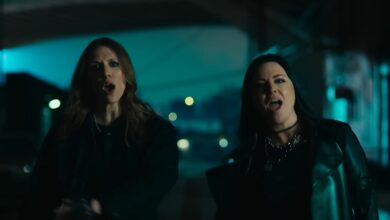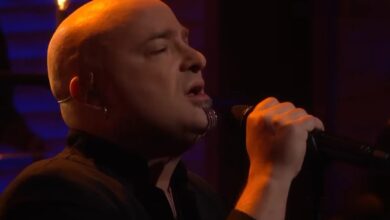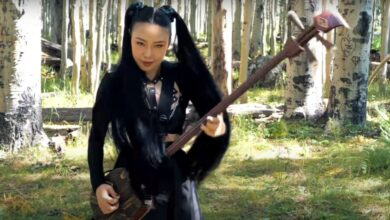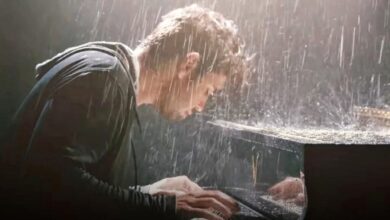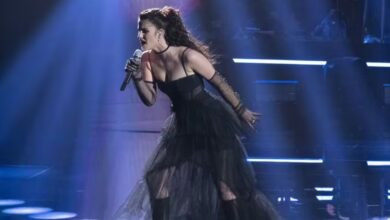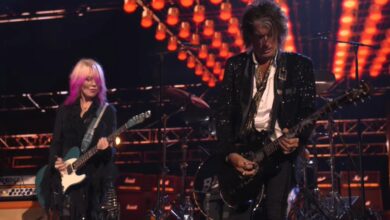The Sound of Silence — Reimagined in the Dark
The first thing you notice is the weight of the opening: a low, resonant note that lands like a curtain drop. It’s not loud for loudness’s sake; it’s an announcement, a signal that this won’t be a museum-piece cover but a dramatic re-staging. When Corvyx enters, the diction is crisp and intimate, almost conspiratorial, drawing you closer instead of bludgeoning you with volume. Then the orchestral swells arrive—sub-bass pulses and cinematic strings that feel more like score than accompaniment—setting the tone for a version that treats a 1960s folk masterpiece as a widescreen thriller without losing its soul.
Part of the magic is how the arrangement balances menace and reverence. The original Simon & Garfunkel composition has always carried a hush, a sense that the singer has walked through something and returned with the news. Corvyx’s take keeps that narrative spine intact, but clothes it in shadow: low piano, reverberant percussion, and choral pads that bloom like distant cathedral choirs. The tempo is deliberate, widening the air between lines so words can hang, decay, and bruise. Rather than racing to the hook, the production invites reflection—and tension—on the way there.
Vocally, the performance builds like a novel. The first verses are tight to the mic—confession-level proximity—before expanding into sustained, open-throated phrases that ride the orchestral lift. Corvyx’s control is the difference-maker: vowels are shaped and held; consonants are placed with storyteller precision. You hear a singer comfortable inhabiting multiple registers without showboating. The power notes come, yes, but they serve the cinematic arc. The point isn’t “can he hit it”; the point is “why does it land that way when he does.”
That “why” comes down to dynamics. The mix refuses the modern loudness war, keeping headroom for the big moments to actually feel big. The impact arrives because whispers are truly whispers and peaks are truly peaks. When the percussion finally snaps through—more thunder roll than snare crack—it’s earned. The strings, which begin as a textural ghost, step forward in the back half to create a stirring counter-voice. The overall effect is filmic: you can practically see a slow push-in shot as the chorus unfurls.
There’s also a clever understanding of lyric dramaturgy. “Hello darkness, my old friend” is not treated as a meme-able catchphrase; it’s treated as a thesis sentence. Each subsequent image—narrow streets of cobblestone, neon gods—gets a fresh coat of gravitas from the arrangement. The orchestration doesn’t paint over the words; it frames them. Even the rests feel scripted, like beats in a dialogue. In a landscape where many covers rely on one big twist, this version’s twist is patience.
Comparisons are inevitable, especially to the massively popular heavy-ballad reboot that introduced a new generation to the song. Corvyx charts a parallel road: still dark, still soaring, but with a different emotional color. Where other interpretations lean into granite-dense baritone power, this one plays with chiaroscuro—light and shadow across a wider vocal palette. That difference keeps the familiar fresh. It’s not about out-singing anyone; it’s about altering the light falling on the same statue so new lines appear.
The “cinematic” tag isn’t just branding—it’s production grammar. Long-tail reverbs create a sense of physical space; timed delays pulse with the tempo like a second heartbeat; low-register synths act as a subterranean drone that you feel before you identify. These choices move the song from coffeehouse confessional to late-night IMAX without sacrificing intimacy. It’s the same melody, but now it has a horizon line.
Audience response has followed a predictable but gratifying curve: first surprise (“whoa, this is darker than I expected”), then immersion, then evangelism. You can tell a cover clicked when the comment threads shift from “nice job” to full-on comparative literature—people parsing arrangements, swapping favorite lines, and debating where this version sits in the expanding canon of “Sound of Silence” reworks. That discourse is a metric: listeners don’t just like the video; they live in it for a while.
Another reason the performance resonates is the story behind the artist. Corvyx has spent years refining a lane that he often calls dark-pop or ethereal pop—high-drama, high-clarity vocals set against moody, cinematic beds. That context matters here: this isn’t a one-off detour into somber territory. It’s a crystallization of an aesthetic. The cover feels less like “let’s try a classic” and more like “this classic was always meant to sound like this in my world.”
The release rollout underscored that point. The thumbnail composition, color grading, and typography tell you before you hit play that mood is part of the message. Visual storytelling matters in the algorithm era; a frame must telegraph genre and tone in half a second. This one does. Inside the video, lighting and framing treat the vocalist as both narrator and instrument—no busy cuts, no camera gymnastics, just the face and the voice carrying the frame while the soundscape blooms around them. It’s restraint as strategy.
Then there’s the community layer. Corvyx’s audience—often called a “coven” in his mythology—has powered multiple releases with direct support. That patron-driven ecosystem changes the creative equation; it incentivizes riskier arrangements that mainstream A&R might second-guess. The “Cinematic Dark Version” of “The Sound of Silence” feels like the product of that feedback loop: an audience that rewards atmosphere, a creator who can invest in orchestration and mix detail because a base of listeners shows up, on purpose, every time.
From a technical perspective, the track is a case study in modern hybrid production. Orchestral elements sit alongside electronic design without either losing identity. The low end is carefully managed so the sub doesn’t smother the spoken consonants in the verses; multi-band compression tames the swells without flattening them. The master preserves transients enough to keep the percussive entrances dramatic. Headphones reveal how much of the experience is stereo field choreography—strings tucked left, pads ghosting right, lead centered and forward like a lighthouse beam.
Culturally, the choice of song is savvy. “The Sound of Silence” is public consciousness glue—recognizable across generations, malleable enough to bear new meaning in new times. Every era reclaims it for its own anxieties. A “cinematic dark” reading in 2023–2025 speaks to our appetite for serious pop: big feelings, big sonics, zero irony. The cover captures that mood without pandering. It’s refined escapism—the kind that stares into the abyss but brings a flashlight.
One underappreciated facet is how the arrangement honors silence itself. The spaces between lines are not filler; they’re narrative oxygen. In a content economy addicted to constant stimulation, leaving room for a thought to land feels radical. You can hear listeners adjusting their breathing to the song’s cadence, which is as close to proof as we get that music is a bodily art before it’s a cerebral one. This version makes you sit still, and that stillness becomes its own spectacle.
Longevity is the final test. Viral covers can spike and vanish; repertoire additions stick. The signs point to “stick.” Playlist placements, cover reaction videos, and repeat watch counts suggest that people aren’t just sampling— they’re returning. That’s the tell of a cover that has entered rotation, not just conversation. It becomes a version you consider when you think of the song, not merely a novelty you once clicked on at 2 a.m.
If you zoom out, the broader story is about “heritage meets hyper-modern.” A mid-’60s folk anthem becomes a 21st-century cinematic ballad without losing the moral clarity that made it an anthem. The transformation isn’t cosmetic; it’s architectural. New beams, same foundation. That’s how classics survive: not by freezing in amber but by proving they can breathe different air and still speak clearly. Corvyx’s “Sound of Silence” does exactly that—breathes different air, speaks clearly, and leaves you quieter than it found you.
